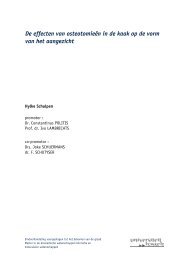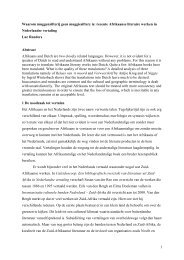Planning Problems in Intermodal Freight Transport ...
Planning Problems in Intermodal Freight Transport ...
Planning Problems in Intermodal Freight Transport ...
You also want an ePaper? Increase the reach of your titles
YUMPU automatically turns print PDFs into web optimized ePapers that Google loves.
5.3 Network Operator<br />
Network operators have to take daily decisions on the load order of tra<strong>in</strong>s and barges.<br />
Feo and González-Velarde [58] study the problem of optimally assign<strong>in</strong>g highway trailers to<br />
railcar hitches (‘piggyback’ transport) <strong>in</strong> <strong>in</strong>termodal transportation. The problem is def<strong>in</strong>ed as<br />
a set cover<strong>in</strong>g problem and formulated as an <strong>in</strong>teger l<strong>in</strong>ear program. Two methods are<br />
proposed to m<strong>in</strong>imize a weighted sum of railcars used to ship a given set of outbound trailers.<br />
First a general purpose branch-and-bound code is applied, second a Greedy Randomized<br />
Adaptive Search Procedure (GRASP) is developed to approach optimal solutions. The<br />
heuristic <strong>in</strong>corporates a selection of the most difficult to use railcars available together with<br />
the most difficult to assign trailers. In do<strong>in</strong>g this, the least compatible and most problematic<br />
equipment is considered first. Feo and González-Velarde [58] only consider the local trailer<br />
assignment problem at a s<strong>in</strong>gle yard, at a s<strong>in</strong>gle po<strong>in</strong>t <strong>in</strong> time. Powell and Carvalho [59] want<br />
to <strong>in</strong>troduce network level <strong>in</strong>formation to improve decisions made at a local level. The<br />
previous model ignores the importance the choice of dest<strong>in</strong>ation has <strong>in</strong> the aim to fully utilise<br />
the equipment. For example, if the conta<strong>in</strong>er is go<strong>in</strong>g to a dest<strong>in</strong>ation that pools a large<br />
number of trailers, flatcars are favoured that can carry trailers. Network <strong>in</strong>formation such as<br />
this can <strong>in</strong>fluence the decisions made by the local term<strong>in</strong>al. Powell and Carvalho [59] propose<br />
a dynamic model for optimiz<strong>in</strong>g the assignment of trailers and conta<strong>in</strong>ers to a flatcar. The<br />
problem is formulated as a logistics queu<strong>in</strong>g network which can handle a wide range of<br />
equipment types and complex operat<strong>in</strong>g rules. The reposition<strong>in</strong>g of railroad-owned equipment<br />
is <strong>in</strong>tegrated <strong>in</strong> this problem formulation.









